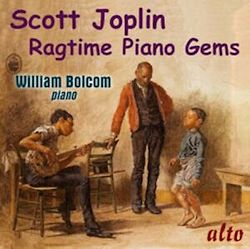 BUY NOW AmazonUK AmazonUS |
JOPLIN: RAGTIME PIANO GEMS William Bolcom, piano
|
1. Original Rags (4:33)
2. Fig Leaf Rag (5:01)
3. Maple Leaf Rag (3:07)
4. Eugenia (5:16)
5. The Entertainer (4:37)
6. Nonpareil (4:40)
7. Elite Syncopations (3:50)
8. Country Club (4:17)
9. Sugar Cane (3:43)
10. Bethena (5:26)
11. The Ragtime Dance (4:04)
12. Solace (6:02)
13. Searchlight Rag (4:51)
14. Euphonic Sounds (3:25)
15. Gladiolus Rag (4:53)
16. Magnetic Rag (4:01)
TOTAL PLAYING TIME [71:38]
Ragtime music first appeared in the 1880’s in the saloons and brothels centered around St. Louis, Missouri. A sleepy Midwest port along the Mississippi River, St. Louis was growing into a major city and cultural center, as well as a gateway for newcomers migrating to the west. Ragtime developed it’s unique style by blending European structure with African rhythms. The term ragtime is a contraction for “ragged time”, or breaking up a melody into pieces. On the piano, the style is characterized by a steady left-hand bass accompanied by a syncopated right-hand melody. Scott Joplin (1868-1917) was an early composer and a major figure in the development of ragtime. This disc presents 16 of his many compositions, performed by William Bolcom on piano.
Scott Joplin’s career as a composer evolved through three phases. He set the bar high during his early development period (1899-1904) by composingOriginal Rags, a joyful ragtime cakewalk; Elite Syncopations, featuring an interesting mix of lyrical styles; Maple Leaf Rag, a brilliant composition published in 1899 that established the standard for construction of sections; and The Entertainer, published in 1902, which became famous again in 1974 as the theme song for the film “The Sting”. His mature phase lasted from 1904 to 1908. Bethena, an unusually-crafted syncopated waltz, was published in 1905. The Ragtime Dance was originally written in 1902 with lyrics as a ballet, and then re-written as a piano rag and published in 1906. Searchlight Rag was published in 1907 and features interesting switches of syncopation between right and left hands. Also published in 1907 were Nonpareil and the majesticGladiolus Rag. In 1908 he wrote the sweet and enticing Sugar Cane, along with Fig Leaf Rag, a classic rag that varies in mood and dynamics. In 1909 Joplin began an experimental and final phase that lasted for five years. During that year he published Country Club, Euphonic Sounds, and Solace, subtitled “A Mexican Serenade”, a haunting syncopated tango with a full-chord right hand melody that sounds like weeping. His last composition was Magnetic Rag, published in 1914, a lively, complex piece, traditional in rag structure yet different and very individual in character; a fitting piece to end this disc while saluting a unique composer and a sample of his singular body of work.
William Bolcom is a well-known pianist, composer and accomplished Grammy Award winner, and has also been awarded the Pulitzer Prize and the National Medal of Arts for his music accomplishments. His interpretations of Joplin’s work and performance on this disc are outstanding. This music was originally recorded in 1988, and was re-mastered by Paul Arden-Taylor. The sound quality is excellent.
Bruce McCollum